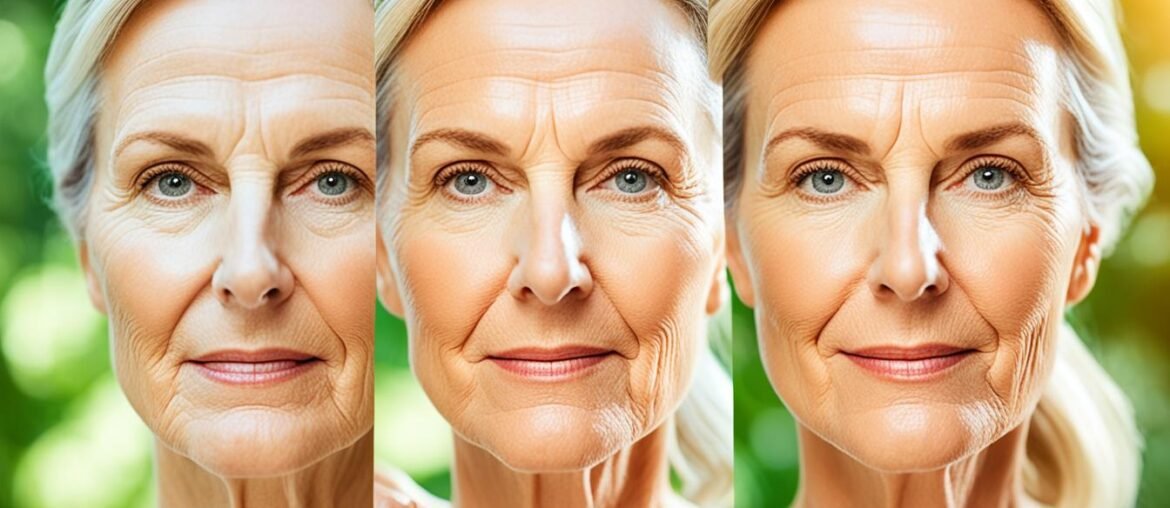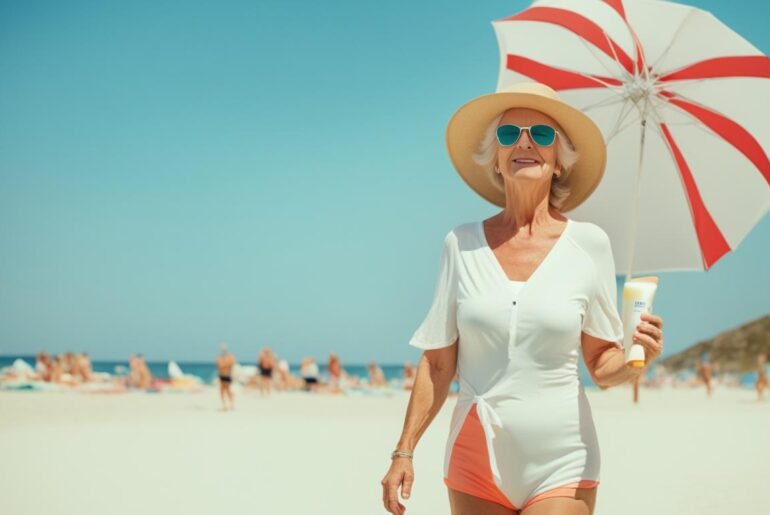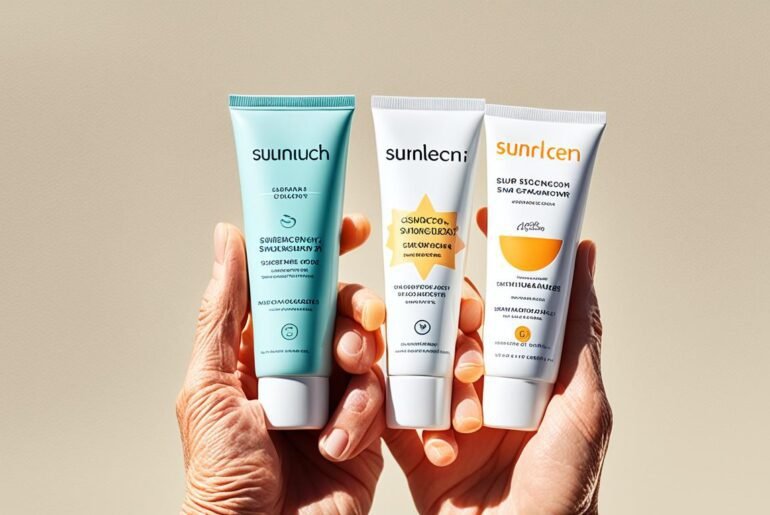Photoaging, the premature aging of the skin caused by UV radiation, can result in wrinkles, fine lines, skin discoloration, and a loss of skin elasticity. While we cannot reverse the DNA damage caused by sun exposure, there are treatments available to improve the appearance of sun-damaged skin. By reducing spots, stimulating collagen production, and smoothing out the skin, we can rejuvenate mature skin and reverse the effects of sun damage.
Key Takeaways:
- 90% of visible skin aging is caused by sun exposure.
- Photoaging can lead to wrinkles, fine lines, skin discoloration, and loss of skin elasticity.
- Treatments can improve the appearance of sun-damaged skin by reducing spots and stimulating collagen production.
- Prevention, such as using sunscreen and wearing protective clothing, is crucial in protecting the skin from sun damage.
- By understanding the risks and taking necessary precautions, we can reverse and prevent sun damage, restoring our skin’s youthful radiance.
What is Photoaging and How Does it Differ from Chronological Skin Aging?
Photoaging is the premature aging of the skin caused by ongoing exposure to UV radiation from the sun or artificial sources. This exposure leads to sun damage, including the formation of wrinkles, fine lines, skin discoloration, and a loss of skin elasticity. Unlike chronological skin aging, which is a natural process that occurs with age and genetics, photoaging is preventable and can be significantly reduced through precautions and treatments.
UV radiation from the sun or tanning beds penetrates the skin and causes DNA changes in skin cells. These changes contribute to the development of photoaging, as well as an increased risk of skin cancer. It is essential to protect the skin from UV radiation to prevent and minimize sun damage. This can be achieved by wearing broad-spectrum sunscreen with a high SPF, using protective clothing such as hats and long sleeves, seeking shade, and avoiding peak sun hours.
By understanding the differences between photoaging and chronological skin aging, individuals can take the necessary precautions to protect their skin from the damaging effects of UV radiation and maintain a healthy and youthful complexion.
Can Sun Damage be Reversed?
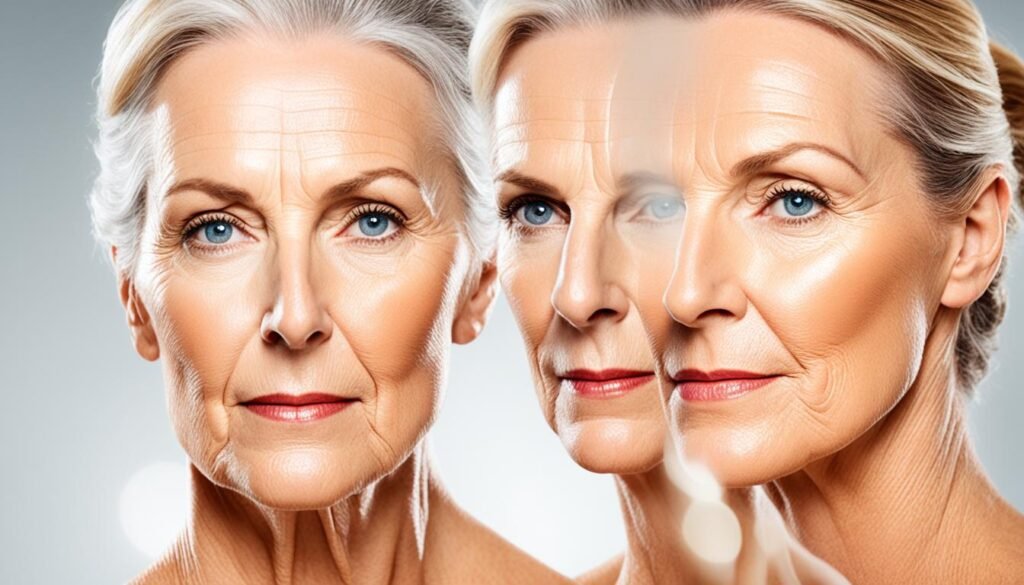
Once UV radiation changes the DNA of skin cells, the damage cannot be reversed. However, there are various treatments available to treat, reduce, and repair the appearance of sun-damaged skin. These treatments aim to improve the look, tone, and quality of the skin, addressing issues such as spots, discolorations, wrinkles, fine lines, and skin texture.
One effective method for treating sun-damaged skin is through spot removal and skin rejuvenation procedures. These procedures can reduce the appearance of sun spots, age spots, and other skin discolorations, resulting in a smoother and more even-toned complexion.
Skin resurfacing treatments, such as chemical peels and laser therapies, can also help repair sun-damaged skin by promoting the growth of new skin cells and collagen production. These treatments address fine lines, wrinkles, and skin texture irregularities, giving the skin a smoother and more youthful appearance.
Additionally, topical treatments such as retinoids and vitamin C serums can improve the overall appearance of sun-damaged skin. Retinoids, derived from vitamin A, work by increasing cell turnover and stimulating collagen production, thus reducing fine lines, wrinkles, and uneven skin tone. Vitamin C serums are known for their antioxidant properties, which help protect the skin from further damage and brighten the complexion.
It is important to note that while these treatments can improve the appearance of sun-damaged skin, prevention is crucial in protecting the skin from further damage. Daily sun protection, including the use of broad-spectrum sunscreen, wearing protective clothing, and seeking shade, can help reduce the harmful effects of UV radiation and minimize the risk of future sun damage.
Most Visible Areas of Photoaging
When it comes to the visible signs of photoaging, certain areas of the body are more prone to sun damage than others. These sun-damaged areas commonly include the face, neck, hands, arms, legs, and upper chest.
Exposure to UV radiation from the sun can cause various effects on the skin in these areas, ranging from wrinkles and fine lines to age spots and a loss of skin elasticity. The face, being one of the most exposed areas, often shows visible signs of photoaging, such as deep-set wrinkles and discoloration.
The neck, a commonly neglected area when it comes to sun protection, is also susceptible to sun damage, resulting in sagging skin and the formation of horizontal lines, often referred to as ‘necklace lines’.
The back of the hands, arms, and legs, being constantly exposed to the sun, can develop characteristic signs of photoaging, such as age spots and a thin, crepey texture.
Lastly, the upper chest is another area prone to sun damage, often showing visible signs of photoaging in the form of deep wrinkles and uneven skin tone.
To minimize the visible signs of sun damage in these areas, it is essential to protect and care for them. This includes regular use of sunscreen, wearing protective clothing, and seeking shade whenever possible. By taking these preventive measures, you can help maintain the health and appearance of these visible areas, promoting overall skin rejuvenation.
Who is at Risk for Sun-Damaged Skin?

When it comes to sun-damaged skin, certain individuals are more at risk due to various factors. Understanding these risk factors can help individuals take the necessary precautions to protect their skin from the damaging effects of UV radiation.
People with a light skin tone are more susceptible to sun damage. The fairer the skin, the less melanin it contains, which provides natural protection against UV rays. Therefore, individuals with light skin tones should take extra care to shield their skin from intense sun exposure.
A family history of skin cancer also increases the risk of sun damage. Genetics play a role in determining an individual’s skin type and vulnerability to UV radiation. If someone in your family has had skin cancer, it is crucial to be proactive in protecting your skin.
Having many moles or freckles on the skin may indicate a higher risk of sun damage. These characteristics could signal a greater susceptibility to the harmful effects of UV radiation.
Individuals who experience intense sun exposure are also more prone to sun damage. This includes individuals who spend a lot of time outdoors, especially under direct sunlight, or frequent tanning salons. It is important to be mindful of the potential risks associated with prolonged sun exposure.
Living or vacationing in high-altitude areas can increase the risk of sun-damaged skin. At higher altitudes, the atmosphere is thinner, allowing for more UV radiation to reach the Earth’s surface. This means that individuals in these areas may experience more intense sun exposure without even realizing it.
Summary:
Individuals with a light skin tone, a family history of skin cancer, many moles or freckles, intense sun exposure, or a tendency to vacation or live in high-altitude areas are more at risk for sun damage. It is crucial for these individuals to take extra precautions, such as using broad-spectrum sunscreen, wearing protective clothing, seeking shade, and minimizing time spent in tanning salons or under direct sunlight.
| Risk Factors | Description |
|---|---|
| Light skin tone | Fairer skin with less melanin, providing less natural protection against UV radiation. |
| Family history of skin cancer | Having relatives who have had skin cancer increases the risk of sun damage. |
| Many moles | A higher number of moles on the skin may indicate an increased vulnerability to sun damage. |
| Freckles | Individuals with freckles may have a greater susceptibility to the harmful effects of UV radiation. |
| Intense sun exposure | Spending a significant amount of time outdoors, especially under direct sunlight or in tanning salons. |
| High altitudes | Living or vacationing in areas with thinner atmospheres, allowing for more intense UV radiation. |
Effects of Sun Damage on People of Color
People of all skin tones are exposed to UV radiation and at risk for sun damage. However, people of color are less likely to get sunburned due to the higher amount of melanin in their skin, which provides some protection against UV rays.
However, it’s important to note that people of color can still experience sun damage and sunburn, which can be painful and cause skin peeling. Although there is a relationship between sun exposure and skin cancer in lighter-skinned individuals, no such relationship seems to exist in dark-skinned individuals.
When people of color do develop skin cancer, it tends to be on the palms of their hands or the soles of their feet and is often diagnosed at a later stage. This highlights the need for increased awareness and regular skin screenings in dark-skinned individuals to detect skin cancer early.
| Skin Tone | Risk of Sun Damage | |
|---|---|---|
| Less Likely | Still Possible | |
| Light | Higher risk | Yes |
| Dark | Less likely | Yes |
While further research is needed to fully understand the risks of sun damage and the effectiveness of treatments in people of color, it is crucial for individuals of all skin tones to protect their skin from UV radiation by using sunscreen, wearing protective clothing, seeking shade, and getting regular skin check-ups.
Health Conditions and Medications that Increase Sun-Damaged Skin
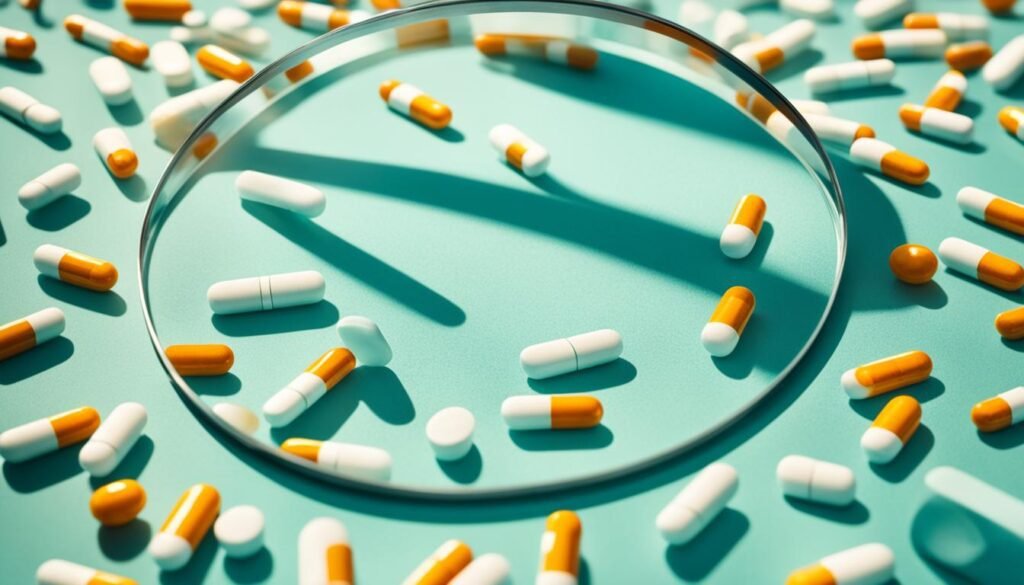
Certain health conditions and medications can increase the risk of sun-damaged skin. People with autoimmune diseases, such as systemic lupus erythematosus, or conditions that weaken the immune system, including HIV, are at higher risk. Additionally, medications that weaken the immune system, such as corticosteroids, biologics, monoclonal antibodies, and calcineurin inhibitors, can increase the risk of sun damage. Certain medications, such as antibiotics, oral contraceptives, and cholesterol-lowering drugs, can make the skin more sensitive to sunlight.
If you have any of these health conditions or take medications that increase sun sensitivity, it’s crucial to take extra precautions to protect your skin from the damaging effects of UV radiation. This includes consistently using broad-spectrum sunscreen, wearing protective clothing, and seeking shade when the sun is strongest.
Autoimmune Diseases and Sun Damage
Autoimmune diseases, such as systemic lupus erythematosus (SLE), can increase the risk of sun-damaged skin. SLE is a chronic autoimmune disease that affects multiple organs and tissues, including the skin. Sunlight exposure can trigger or worsen symptoms in individuals with SLE, leading to increased photosensitivity and sun damage.
Weakened Immune System and Sun Damage
A weakened immune system, whether from a medical condition or medication, can also make the skin more vulnerable to sun damage. Conditions such as HIV, which weaken the immune system, can increase the risk of sun-damaged skin. Additionally, certain medications used to treat autoimmune diseases or organ transplant recipients, such as corticosteroids, biologics, monoclonal antibodies, and calcineurin inhibitors, can weaken the immune system and increase sun sensitivity.
Medications that Make Skin More Sensitive to Sunlight
Some medications can make the skin more sensitive to sunlight, increasing the risk of sun damage. Antibiotics, oral contraceptives, and certain cholesterol-lowering drugs are examples of medications that can increase photosensitivity. If you are taking any of these medications, it is important to be aware of the potential risks and take steps to protect your skin from UV radiation.
Tips for Preventing Sun Damage and Maintaining Healthy Skin

Prevention is key when it comes to protecting your skin from sun damage. By following a few simple steps, you can minimize the risk of sun damage and maintain healthy, radiant skin.
First and foremost, make sunscreen your best friend. Use a broad-spectrum sunscreen with an SPF of at least 30 to protect against both UVA and UVB rays. Apply a thick layer to all exposed skin and don’t forget to cover often neglected areas such as your ears, the back of your neck, and the tops of your feet. Reapply every 80 minutes and immediately after swimming or sweating.
Wearing protective clothing is another crucial step in preventing sun damage. Opt for long sleeves, pants, and wide-brimmed hats. Look for lightweight, breathable fabrics with built-in UPF (Ultraviolet Protection Factor) for added protection.
Seek shade whenever possible, especially during the peak sun hours of 10 AM to 4 PM. If you must be outdoors, try to find shady areas or create your own shade with umbrellas or sun shelters.
Establish sun-safe habits by incorporating sunscreen and protective measures into your daily skin care routine. Make it a habit to apply sunscreen at least 30 minutes before going outside and reapply as needed throughout the day. Consider using makeup, moisturizers, and lip balms with added SPF for added protection.
Avoiding peak sun hours is essential to reduce your exposure to harmful UV radiation. Plan outdoor activities early in the morning or later in the afternoon when the sun’s rays are less intense.
Lastly, develop a comprehensive skin care routine that includes proper cleansing, moisturizing, and exfoliating. Use products that are specifically formulated for your skin type and address your unique concerns.
By following these tips and incorporating sun-safe habits into your daily routine, you can effectively prevent sun damage and maintain healthy, beautiful skin.
Conclusion
In conclusion, reversing sun damage on mature skin is possible through various treatments and a healthy skin care routine. While we cannot reverse the DNA damage caused by UV radiation, we can improve the appearance of sun-damaged skin. Treatments like reducing spots, smoothing the skin, and stimulating collagen production can help restore a youthful complexion. However, prevention is the key to protecting the skin from sun damage.
By incorporating daily sun protection measures, such as wearing broad-spectrum sunscreen and protective clothing, and seeking shade, we can minimize the risk of sun damage. It is also important to create a healthy skin care routine that includes regular cleansing, moisturizing, and exfoliating. By understanding the risks and taking necessary precautions, we can both reverse and prevent sun damage, ensuring our skin remains healthy and radiant.
Remember, reversing sun damage is a gradual process that requires patience and consistency. By prioritizing healthy skin care practices and protecting our skin from harmful UV rays, we can maintain the health and appearance of our skin for years to come.
FAQ
What is photoaging and how does it differ from chronological skin aging?
Photoaging is the premature aging of the skin caused by ongoing exposure to UV radiation from the sun or artificial sources. It leads to sun damage, including wrinkles, fine lines, skin discoloration, and a loss of skin elasticity. Photoaging is different from chronological skin aging, which is a natural process that occurs with age and genetics.
Can sun damage be reversed?
While the DNA damage caused by UV radiation cannot be reversed, the appearance of sun-damaged skin can be improved through treatments that reduce spots, smooth out the skin, and stimulate collagen production.
What are the most visible areas of photoaging?
The most visible areas of photoaging and sun damage are commonly found on the face, neck, back of the hands, arms, legs, and upper chest. These areas are exposed to the sun and are more susceptible to the damaging effects of UV radiation.
Who is at risk for sun-damaged skin?
People with light skin tones, a family history of skin cancer, many moles, freckles, and a tendency to burn before tanning are more at risk for sun-damaged skin. Additionally, those who live or vacation at high altitudes, get intense sun exposure on weekends, spend a lot of time outdoors, or frequent tanning salons are more prone to sun damage.
What are the effects of sun damage on people of color?
People of color are less likely to get sunburned due to the higher amount of melanin in their skin, which provides some protection against UV rays. However, people of color can still experience sun damage and sunburn. While there is a relationship between sun exposure and skin cancer in lighter-skinned individuals, no such relationship seems to exist in dark-skinned individuals. Further research is needed to fully understand the risks of sun damage and the effectiveness of treatments in people of color.
What health conditions and medications increase the risk of sun-damaged skin?
People with autoimmune diseases, such as systemic lupus erythematosus, or conditions that weaken the immune system, including HIV, are at higher risk. Additionally, medications that weaken the immune system, such as corticosteroids, biologics, monoclonal antibodies, and calcineurin inhibitors, can increase the risk of sun damage. Certain medications, such as antibiotics, oral contraceptives, and cholesterol-lowering drugs, can make the skin more sensitive to sunlight.
What are some tips for preventing sun damage and maintaining healthy skin?
Prevention is key in protecting the skin from sun damage. Use broad-spectrum sunscreen with an SPF of at least 30, apply a thick layer to all exposed skin, and reapply every 80 minutes and after swimming or sweating. Wear protective clothing, such as hats and long sleeves, and seek shade, especially between 10 AM and 4 PM when the sun is strongest. Establish sun-safe habits, avoid peak sun hours, and incorporate sunscreen and protective measures into your daily skin care routine.
Can sun damage on mature skin be reversed?
While the DNA damage caused by UV radiation cannot be reversed, the appearance of sun-damaged skin can be improved through various treatments that reduce spots, smooth out the skin, and stimulate collagen production. Prevention is key in protecting the skin from sun damage, and incorporating daily sun protection measures and a healthy skin care routine can help maintain the health and appearance of the skin.

